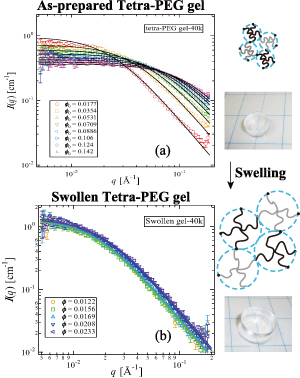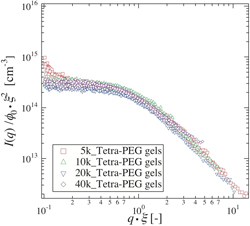Inhomogeneity-Free Tetra-PEG Gels as Revealed by Small-Angle Neutron Scattering
Shibayama Group
It is well known that polymer gels have inhomogeneous structures, such as non-uniform distribution of cross-links, dangling chains, and trapped entanglements. The inhomogeneous structures are ascribed to an introduction of cross-links to a polymeric system, which fixes the topological architecture of the system. These inhomogeneities are often characterized by an upturn in the scattering intensity at low q-region in small-angle neutron scattering (SANS) or a speckle pattern in laser light scattering, where q is the magnitude of the scattering vector. Since the physical properties of gels, such as mechanical and optical properties, strongly depend on the structure, it is extremely important to clarify the relationship between the structure and mechanical properties. The understanding of cross-link inhomogeneities is vital from both scientific and engineering points of view since they affect the physical properties of the network polymer, such as mechanical and optical properties. On the other hand, there has been a desire to prepare an "ideal" polymer network free from defects.

Fig.1. SANS curves of (a) as-prepared and (b) swollen Tetra-PEG gels observed at various polymer volume fractions, φ0 and φ, where φ0 and φ are the volume fraction at preparation and at observation, respectively. All SANS curves are represented simply by OZ functions with the correlation length of ξ. The cartoons show the molecular architecture of Tetra-PEG gels. The photographs show as-prepared (top) and swollen gels (bottom).

Fig.2. SANS master curves for as-prepared Tetra-PEG gels (Mw = 5, 10, 20, and 40 kg/mol). All SANS curves can be superimposed to a single master curve by using the reduced variables of ξq and I(q)/φ0ξ2.
We developed a novel class of hydrogels "Tetra-PEG" gels by cross-end coupling of two-types of tetra-arm polyethylene glycol (PEG) chains.[1] The Tetra-PEG gels have various advantages, namely, high mechanical strength and toughness (stronger than cartilage), easy preparation (simple mixing of two aqueous solutions), and biocompatibility (direct implantation by injection). The Tetra-PEG gels were prepared by cross-end coupling of two types of tetra-arm PEG macromers with the molecular weights, Mw, of 5, 10, 20 and 40 x 103 g/mol. Interestingly, it was found that Tetra-PEG gels did not show the above-mentioned upturn behavior at low q-regions (q > 0.01 Å-1) in SANS [2-4]. The structure factors of both as-prepared and swollen gels were represented only by Ornstein-Zernike (OZ) type scattering functions, i.e., I(q) = I(0)/(1 + ξ2q2), (Fig. 1) and could be superimposed to a single master curve (Fig. 2) with the reduced variables, ξq and I(q)/φ0ξ2, irrespective of the molecular weight of tetra-PEG, where ξ, I(q), and φ0 are the correlation length, the scattering intensity, and the polymer volume fraction at preparation, respectively. The SANS curves for swollen gels were independent of φ0 (the polymer volume fraction at observation), indicating that Tetra-PEG gels are entanglement-free model networks. We then concluded that the extraordinary toughness of Tetra-PEG gels was ascribed to a “perfect” and “ideal” network like a diamond-like tetrahedral structure.
References
- T. Sakai, T. Matsunaga, Y. Yamamoto, C. Ito, R. Yoshida, S. Suzuki, N. Sasaki, M. Shibayama, and U. Chung, Macromolecules 41, 5739 (2008).
- T. Matsunaga, T. Sakai, Y. Yamamoto, Y. Akagi, U. Chung, and M. Shibayama, Macromolecules 42, 1344 (2009).
- T. Matsunaga, T. Sakai, Y. Akagi, U. Chung, and M. Shibayama, Macromolecules 42, 6245 (2009).
